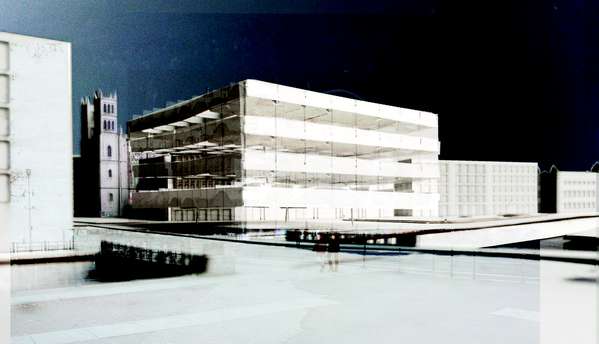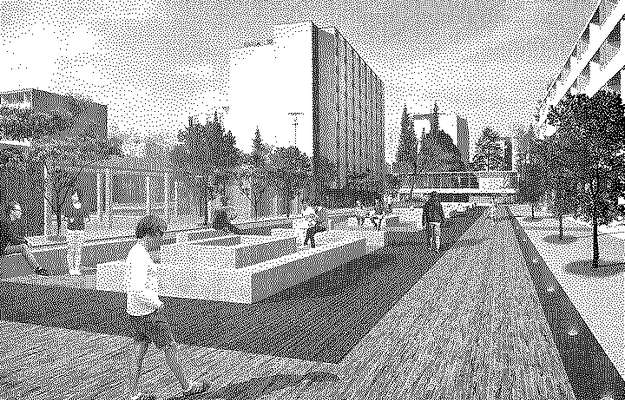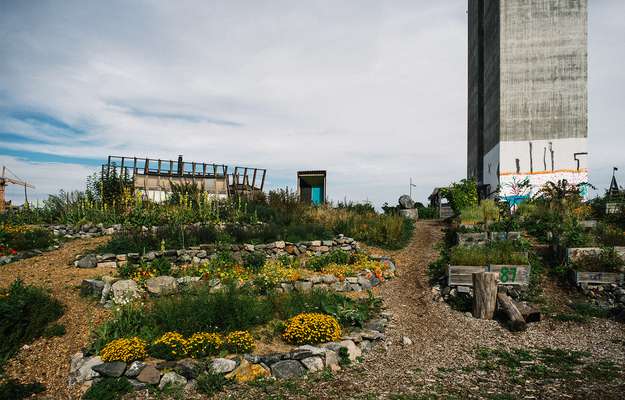Ceci n’est pas une Bauakademie. Neue Bauakademie Berlin.
Excerpt from the chapter ‘Ceci n’est pas une Bauakademie’ Inspired in the project ‘Neue Bauakademie Berlin. A club for the former & future architecture’ by Hendrik Brinkmann. The text is featured in the forthcoming book ‘Fables and Constructions’ by Lucie Kohoutová & Martina Freitagová. This is the title of the winning entry for the FINAL_FINAL writing grant launched by dpr-barcelona within the Future Architecture 2019 Call for Ideas.

Berlin, 11 May 2019
Dear Susanne,
It’s been thirteen years since my last visit and the place still looks the same. The redbrick façade, white stripes, large windows and, in fact, the whole building looks like it’s constructed in virtual reality. In moments of stronger wind, the plastic sheet doesn’t stick properly to the scaffolding and uncovers the bowels of the building. On my regular walk along the Spree canal, I couldn’t resist the temptation to peek inside. I wasn’t even thinking there might be cameras or people guarding the place. The urge to once again be inside the place where I spent the most intense —and most joyful— time, was more powerful than any control system. I climbed the scaffolding —not high enough to stop me even with a broken hip— and there I was. On the enclosed postcard I’ve marked the exact window for you. The second one from the left. Just behind it, on the ground floor, I used to pace nervously from one end of the hall to the other before they announced the exam results. There are moments when I regret studying politics and not architecture, as they did here back in the late 19thcentury. Although on second thoughts, absorbing the aura of the building with its artistic detailing, the large halls one can get lost in, and wondering about the future visions, I suppose it was equally inspiring for me as an apolitical theorist. It has definitely always been a striking place to return to in my memories since I left Germany for the US. Bauakademie as a title suited the majestic and historically-charged building. Did you know that behind these windows there used to be fancy stores selling royal porcelain? Wouldn’t it be nice if we could go back to that moment and I could indulge you with some new tableware —oh, I know how much we need it!
But restoration is a heated topic here in Germany. How should we reconstruct abuilding while respecting tradition and introducing new links and references to the present? Just before my urban exploration of the Bauakademie, I went to visit the New Museum, which is now covered with a coat of pure white construction by David Chipperfield Architects. There, on the terrace of this minimalist, doorless construction there was a lecture underway. I wasn’t sure whether I could simply join, so I casually leaned against one of the slim white pillars and pretended I was admiring the grounds of what had been Schinkel’s Neuer Packhof. In fact, I was listening carefully. A young architect, Henry or Hendrik (oh, I’m bad with names!), was introducing his project on the reconstruction of the Bauakademie. He looked rather shy, but the research he had done was most impressive. It got me thinking about the universities in America, and the large campuses with more opportunities for leisure than for learning. I’m so used to these that it was rather surprising to hear strong traditionalist voices within the audience, strictly against a sauna —one of the propositions of the young architect, for relaxation after a day of work in the attic space. Honestly, it caused such an outrage that they did not discuss anything else about the project! And there was a lot to discuss. Like a gallery on the ground floor and basement, fully open to the public. I always thought a sacred place like the Bauakademie should be open solely to a select few, so that they can focus completely on bringing our cities to the highest standards, having the same peace and quiet for studying as you find in our synagogue.
Now I think about my little adventure, what if I returned to the reconstructed place again and wasn’t allowed in? I wouldn’t be able to show you the busy Werderscher Markt from behind the windows; to feel the space, its history, and presence. A voice from the audience mentioned something about the primary importance of reconstructing the same state as before. I thought: which “before”? 1836, when it was built? I experienced the building in the 1920s. It was still very much the design of Karl Friedrich Schinkel. Yet, it was different. There was no academy for architects anymore —it served meteorologists and then us, students of political science. Obviously, we are not talking about the time after theSecond World War, when it burned down after severe bombing. The Communists wanted to reconstruct the old city as they did elsewhere in the Eastern Bloc. You see, my cousin from Warsaw once told me a story about the Germans bombing the old town, while the Soviets were watching from across the river. They wanted the city to be in ruins, so they could appear as heroes when they marched in and resurrected the buildings, the past, which people were hanging onto like a beacon of hope, almost with religious fervor. East Berlin seemed to have a similar faith. The Soviets were rebuilding the historical city, but the Bauakademie was quite unlucky. Instead of being recovered, it was torn down and replaced by a brutal-looking uniform mass of glass, steel, and concrete. This one, too, was wiped out a couple of decades later, along with the name of the place. I’m so glad I don’t have to send you a postcard from the Marx-EngelsPlatz anymore!

Who knows if the whole story was bad luck for the Bauakademie? Maybe it was closed, have to escape an alluring theatre stage that prefers appearances to an actual being. The young architect sounds quite convincing about actually opening the place to the public and telling the story of the Bauakademie from its conception. Of course, people cannot easily understand why reconstruction is done the way it is, so history might become the teacher. And a sauna might become not only a place for relaxation and health but also for breaking down the boundaries that architects should dismantle rather than erect. I might be getting a little bit overheated and dreaming about impossible visions here.
I forgot about this strange encounter inside the skeleton of the Bauakademie —right in the center, where a large staircase used to lead up to the auditorium, behind the dense bush of a dark green plant (you would surely know its name and why it thrives there, in a fenced-off desert in the middle of the city). A couple of youngsters were sitting on a blanket having a picnic! I was horrified and scared at the same time, not able to utter a single word. What were they doing there? How did they dare enter the sacred grounds? Did they even know who designed the place? I started to walk as fast as I could, to leave the place at once. Maybe forever.
I will send you another postcard from Paris on my way back home. Until then, a big kiss, a huge hug and take care of yourself and the little rascal. I hope he’s not barking too much while I’m gone. Miss you both.
Yours,
Charlie


